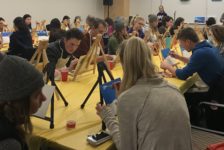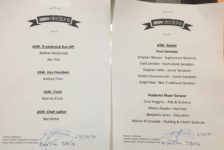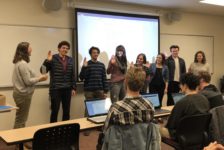
Betsy Kleba and Laura Wolfe collect samples from the Bonneville Salt Flats. Kleba has been conducting research since 2014 through a grant from NASA which looks into microbial life in salt deposits. Photos courtesy Jaimi Butler
Betsy Kleba, associate professor of biology, is looking for signs of life in the saltiest of locations.
Kleba is an expert in infectious diseases and has spent time with the National Institute of Health on human pathogens. One of her ongoing projects is the study of the microbiology and geochemistry of the Bonneville Salt Flats. As of 2014, Kleba has been conducting research in the the Bonneville Flats funded through the Utah NASA EPSCoR grant.
The Bonneville Salt Flats is protected by the Bureau of Land Management as an area of critical environmental concern and a special recreation management area. It spreads over 30,000 acres with around 147 million tons of salt sitting as the remnants of Lake Bonneville.

Betsy Kleba teaches a class at the Bonneville Salt Flats. Kleba is the lead researcher for microbial life in the Bonneville Salt Flats through a grant from NASA.
“Biologists have been looking for exotic lifeforms and lives that can live in what people call extreme environments,” Kleba said. “We couldn’t live there as human beings, but any place we’ve looked on the planet we’ve found microbial life…they found ways to survive in these really unique environments.”
NASA took interest and awarded the grant to Kleba and University of Utah geologist Brenda B. Bowden in 2014. Kleba said the project helped NASA answer the questions, “Who are the organisms that survive these unique environments?” and “Where would we expect to find them?” The project was eventually pitched to the government space research agency.
“If we can send probes to Mars on the surface, the question becomes, ‘Are we looking for just signatures of past life?’ or, ‘If on this planet, [can we] actually have microbial life trapped inside of salt for 250 million years?’” Kleba said. “Then maybe that’s not so far-fetched. Maybe if we’re going to Mars, we could be finding these ancient life forms that are just sort of trapped in salt.”
Kleba’s work outside of the lab has allowed her students to see the practical applications of microbiology in the world around and beyond them.
“Betsy, as a professor, is one of the greatest professors Westminster has,” said Marisol Rodriguez, senior biology major who is Kleba’s research cohort on campus. “She is invested in her students and truly cares about them as well as their understanding of the subject in anything she teaches.”
Kleba said she was looking for how to make microbiology accessible to Westminster students and teach them “how to understand these tiny little lifeforms. We can’t see them, but they’re everywhere and they impact our lives every day in every way imaginable and not imaginable.”
For the final two months of the research, Kleba’s team will be wrapping up the characterization of the cell communities, including looking for cell densities within each specific layer of salt.
Jackson Shaver, senior finance major, has been doing research and working alongside Kleba since Spring 2015.
“I really like working with Betsy,” he said. “It’s cool to learn about what’s going on at the flats. To the eye, it appears that nothing is living in there—it looks like it’s inhospitable. Researching with Betsy, learning about the ecosystem and researching life has been a great experience.”









